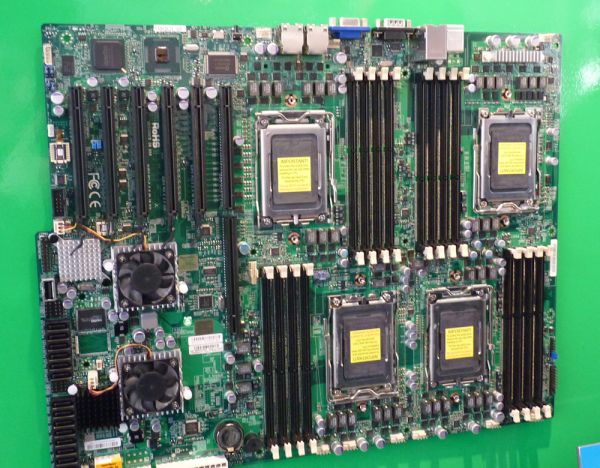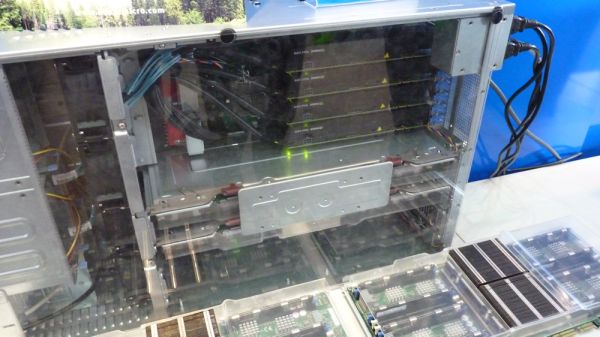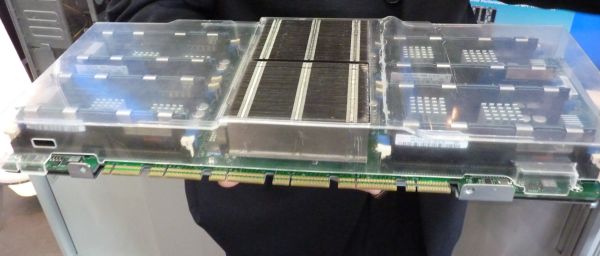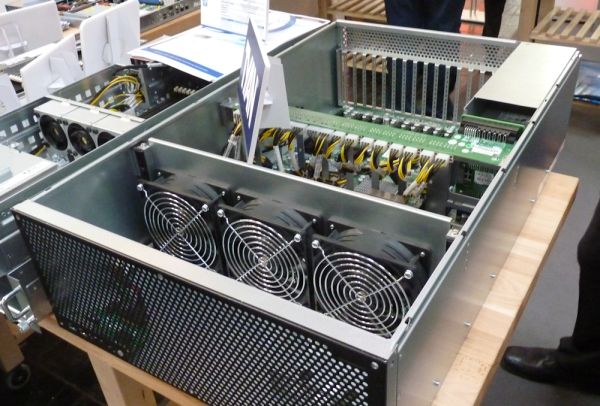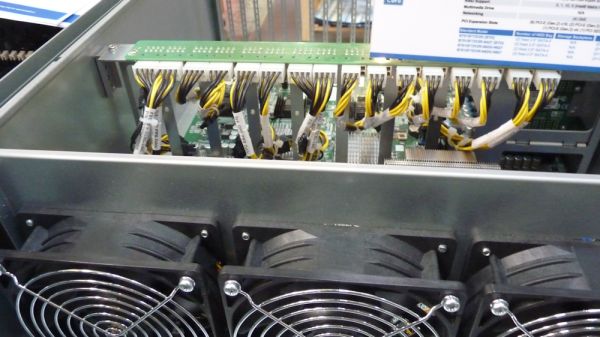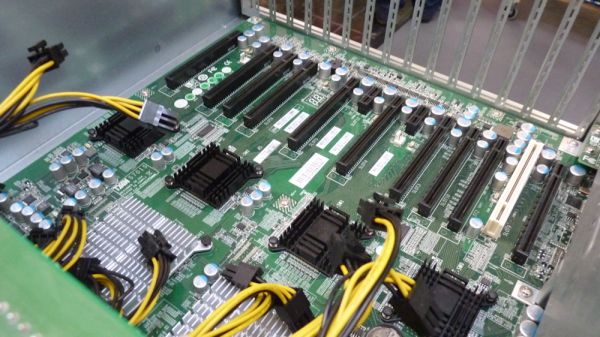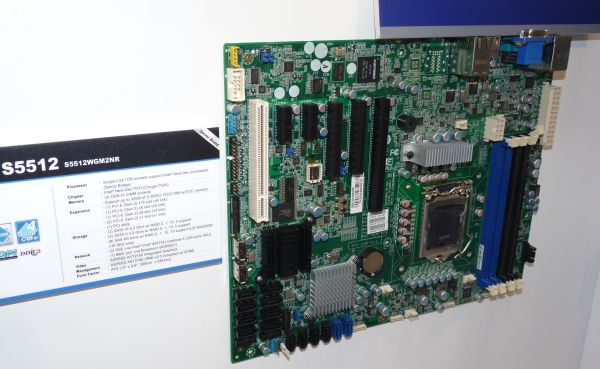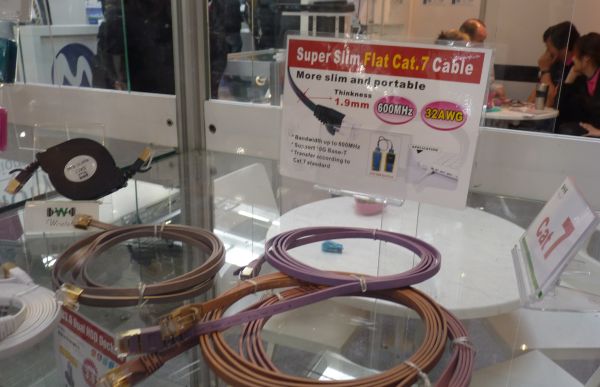
Original Link: https://www.anandtech.com/show/4208/cebit-2011-some-quick-server-related-impressions
Cebit 2011: Some Quick Server Related Impressions
by Johan De Gelas on March 14, 2011 9:21 AM EST- Posted in
- IT Computing
- CeBIT
- Cloud Computing
- Trade Shows
I was surprised to learn that AMD's Torrenza technology, which connects devices directly to the Hyper Transport links of the CPU, is not limited to a few extremely high-end niche markets (like Cray Inc., the supercomputer company).
Supermicro showed its H8QGL-6F+ to us. From a virtualization point of view, this is a pretty mediocre board: only 16 DIMM slots for a total of four G34 sockets, and thus a total of up 48 Opteron 6000 cores. However this board is not targeted at the huge virtualization market. Supermicro daisychained two I/O hub togethers to get 80 PCIe lanes. As a result the board can add the crunching power of 5 GPUs to the 48 Opteron cores .
The HTX slot offers a low latency 6.4 GB/s interface. Together with these kind of "NUMA connected" cards, it is easier to build a very low latency HPC cluster.
However, it seems that the HTX slot is at the end of its lifetime. The upcoming Xeons seem to come with a PCI-express 3.0 controller integrated, so they should be able to offer a low latency interface of up to 12.8 GB/s, or twice as much.
If that is not enough crunching power for you, Supermicro presents you the Superserver 5086B-TRF.
Four daughterboards can each carry two 10-core Westmere-EX. That is good for 80 cores, 160 logical CPUs. Those who have been looking through the new specifications of the VMware vsphere 4.1 update 1 might have noticed that the maximum amount of logical CPUs has been increased from 128 (vSphere 4.1) to 160. No coïncidence if you ask us.
There are 10 PCIe 2.0 slots available, which should make it possible to add 4 GPUs. The maximum amount of memory is an impressive 2 TB (!!), if you equip the server with 64 mega expensive 32 GB DIMMs. At the moment, the server supports only 16 GB DIMMs, so you are "limited" to 1 TB.
This beast is powered by 2+2 Gold Level 2800W power supplies.
Supermicro is a true innovator when it comes to form factors. Two years ago Supermicro invented the Twin² a 2U chassis with four servers. The 4 server nodes were fed by two shared redundant 1200W PSUs. When we heard about the Twin³, we became very curious.
The Twin³ contains 4 hotpluggable units just like the Twin². However, each unit contains two separate motherboards, and as a result there are 8 servers inside this 2U node. The Twin³ is not aimed at the same market as the Twin². The Twin² offers high processing power in a dense, high available chassis.
The Twin³ , also known under the less sexy name Superserver 2015TA-HTRF, is based on the dual-core Intel Atom D525 1.8 GHz. Each node also supports 4 GB of non-ECC DDR3-800 SO-DIMMs, dual Gigabit Ethernet LAN, 2 USB ports, IPMI 2.0 with virtual media over LAN support, and 3x 2.5” SATA hot-swap HDDs. With 4 GB of RAM and a dual-core Atom, we can hardly speak of the Twin³ as a speed daemon.
It is not completely clear to me which market is targeted. According to Supermicro, there are server markets where very low power in idle is important and where little processing power is required. I would personally solve that problem by consolidating all those low intensive workloads on a decently powerful virtualized host with tons of RAM so that you can keep the total amount of servers low. But we have to give this server the benefit of the doubt.
The system also includes (1+1) redundant 720W Gold Level power supplies with PMBus, and four high quality fans. In reality it will be hard to push this system into consuming more than 400W.
Tyan is also after the GPU server market. The 4U barebones FT72-B7015 accepts two Xeon 5600s and up to 18 DIMMs, but that's not what sets it apart. The 10 PCI-e 16x and the special backplane with many 4 pin cables are: the barebone can support up to eight (!) GPU cards.
To feed those power hungry beasts is an available 2+1 1200W power supply configuration.
All this PCI Express goodness is made possible by two Tylersburg (Intel 5520) chipsets and four PLX PEX8647 PCIe switches.
It seems that the fight in this niche market is going to be fierce as other players like ASUS are also offering such server products.
Several vendors were showing LGA 1155 socket boards. These entry-level server boards can use one Sandy Bridge CPU and feature a maximum of 4 DIMM slots.
The Xeon everybody is waiting for is of course the successor to Westmere: the Xeon E-5. Quite a few details have already been disclosed on the web (see here and here), and indeed the octal-core "Romley Xeon" is a pretty impressive chip. Although this CPU is scheduled to be launched in Q4, quite a few server vendors were already showcasing tens of different motherboards for this CPU.
The new Xeon will feature a massive memory subsystem: four channels will be able to drive up to 1600 MHz DDR3 DIMMs. The new Xeons will be able to use DDR3 Load Reduced Dual-Inline Memory Modules, which enables 32 GB DIMMs.
Last but not least, CAT 7 cable is becoming mainstream as even super slim flat cables are available.

